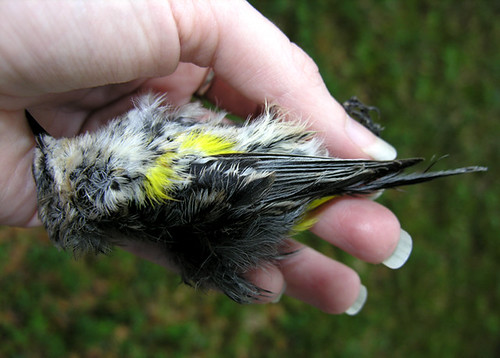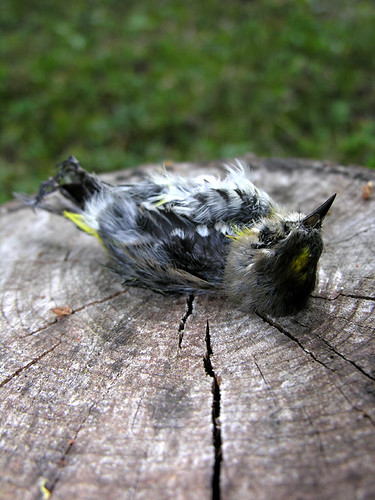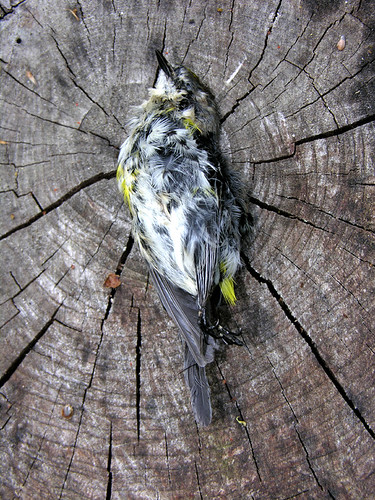Like this Yellow-rumped Warbler, I found laying beautifully in the yard. I could tell it was not killed by any of my cats or dogs because it remained in full, nearly pristine condition.
(Click on any of the images for a larger view.)




The thing about bird remains is that they can stay outside for YEARS and you still may never have a clean skull.
Perfect example being this cardinal head I found long ago that I've had in my "bone box" for all this time.
It just looks more weathered, rained on, and flat now if anything.

So I've decided to hang the Yellow-rumped Warbler remains appropriately over my pet cemetery, from an Egyptian scarab beetle amulet instead. I'm hoping the feathers with slowly wash away leaving a beautiful skeleton.

If it works, I'll have follow-up photos.



7 comments:
i had no idea about the birds thing...so they don't lose their skin and/or feathers?
Hey Steve, glad you left a comment!
I need to do some more research into bird skeletons and such. There must be special techniques that I'm unaware of to get their bodies clean of feathers.
As of right now this bird above is rotting and about to fall apart after all the storms out here this past week. The head is about to fall off the body. And yet, the feathers are still in tact.
There must be a better way.
Wanted to share this comment I received on flickr, from my friend Jean-Christophe in Paris, France:
I read what you wrote about bird remains in bonelust.
I assemble 3 small bird skeletons and 3 big bird. I didn't have this probleme.
- Before it is necessary to remove all the feathers or as much as possible because one can confuse them with small bones like the ribs or they are put in all the possible places...
- Then to place it at the shelters of predatory to let the flies do their work. I placed mine in a small box in figure open on the top and put a stone above.
For my smaller bird (a Blackcap http://en.wikipedia.org/wiki/Blackcap), from the moment where I found it and the moment where I have a finished skeleton, it takes 2 weeks.
You must look at it every day, that will happen very quickly and the maggots eat also the ligaments.
The best one for very small animals is to keep connections (ribcage). Attention, the tendons are more resistant than the bones in the members, better to cut them short, drying will make the rest.
I will perhaps add this small skeletons to my gallery soon, you can already look at the big.
This is an exellent bird skeleton site : http://www.skullsite.com/
Good luck !
---
You can view Jean-Christophe's photostream here:
http://www.flickr.com/photos/galleriejc/
Comment I left on this photo of Jean-Christophe's of a "Fou & Cormoran":
http://www.flickr.com/photos/galleriejc/3347010429
Sorry, I do not know French but I assume that you reconstructed the bone structures of these birds. And that many of the photos in your stream are before and after works you did as well. Excellent work! The bones are so nice and white. I collect roadkill sometimes as well to have the bones. But have not yet reconstructed an entire animal. Very impressive and dedicated work you have done.
Or continued conversation - Jean-Christophe:
Thanks a lot.
You're right this is before and after work. On this pic, this is my grandfather who holds the cormorant.
I did 16 skeletons, I have a Woodcock in preparation and I just found a roadkill Red-legged Partridge. I have also 2 small birds in the freezer while waiting...
For translation you can use it : babelfish.yahoo.com ask me if you want ; why don't you try to do skeleton ?
What do you think of the bird skeleton site ?
Me:
Thanks for the translator website, the site I use isn't so good!
That skeleton site is EXTREMELY impressive as well as all of the sites on your profile here. I have added all of them to my Bonelust blog :)
I'm going to add a link to your flickr photostream too now that I think of it!
Next time I have a full carcass maybe I'll try to reassemble a skeleton. I need to do a lot more research though first and buy some tools and such. And I'm currently unemployed so it may have to wait.
Hi Jana!
I love all of your work and you inspire me so much! Recently i found a small bird in the snow in my yard. I had hopes to possibly preserve the heart and or other organs because there is alot of snow here so macreation wont go so well... and if i brought it inside my house my parents would flip. I figured if there was anyone who knew the best -itd be you! Thanks so much!
Hi Gary...
I really need to make a blog post about small animal processing but have not yet. Give me an entire adult deer & I can process it for the bones no problem. But it is the tiny reptiles, amphibians, rodents, birds & etc that I have the hardest time processing. You can't macerate like you do with medium sized animals (raccoon, opossum, etc) & up (deer, boar, cattle). The bones can literally be eaten up by the bacteria that defleshes larger bones. You also can't simply let dermestid beetles help with a skeleton this small. I tried, and this is all they left me from 8 full lizards. Although I may try that again with a more controlled environment where I watch more closely with fewer beetles. In the meantime, it comes down to painstakingly slowly & carefully removing the flesh by hand with tweezers & scalpel after rehydrating it. A very tedious process. Once I myself take the time to master this process I will make a blog about it.
thanks... jana
Post a Comment